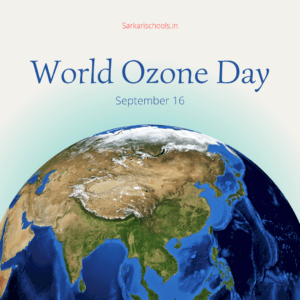20 Facts About The Ozone Layer in English: Discover 20 essential facts about the ozone layer, from its composition and protective role to the impact of human activities and the success of the Montreal Protocol. Explore its significance, health implications, and the ongoing efforts to safeguard this crucial layer of our atmosphere.

20 Facts About The Ozone Layer in English
Let us begin by understanding the facts about the ozone layer:
- The Ozone Layer’s Vital Role: The ozone layer, found in the Earth’s stratosphere, plays a critical role in shielding life on our planet from the harmful ultraviolet (UV) radiation emitted by the sun. It acts as a natural sunscreen, protecting us from the harmful effects of excessive UV radiation.
- Health Implications: Excessive UV radiation exposure can lead to serious health problems, including skin cancer, cataracts, and weakened immune systems. By preserving the ozone layer, we are directly safeguarding our own health and well-being.
- Biodiversity Protection: The ozone layer is not just about human health; it also has a profound impact on ecosystems and biodiversity. UV radiation harms marine life, terrestrial plants, and animals, leading to disruptions in food chains and ecosystems.
- Historical Concerns: A few decades ago, our planet faced a grave environmental crisis as the ozone layer was being depleted at an alarming rate. This depletion was primarily due to the widespread use of ozone-depleting substances like chlorofluorocarbons (CFCs) in refrigeration, air conditioning, and aerosol propellants.
- International Response: In response to the ozone depletion crisis, the international community took unprecedented action. In 1987, the Montreal Protocol on Substances that Deplete the Ozone Layer was adopted. This treaty, ratified by 197 countries, called for the phasing out of ozone-depleting substances.
- Success Story: The Montreal Protocol stands as one of the most successful international environmental agreements in history. Thanks to this treaty, we have seen significant progress in ozone layer recovery. The ozone hole, once a dire symbol of environmental degradation, is gradually healing.
- Continued Challenges: While we have made remarkable progress, challenges remain. New ozone-depleting substances continue to emerge, and the threat of climate change further complicates ozone recovery efforts. Stratospheric ozone levels are still not fully restored to pre-1980 levels.
So, what can we do as individuals and as a global community to address these challenges and continue preserving the ozone layer?
- Stay Informed: Educate yourself and others about the importance of the ozone layer and the ongoing efforts to protect it.
- Responsible Consumer Choices: Choose products that are free of ozone-depleting substances. Look for labels or certifications indicating ozone-friendly products.
- Support Policy Measures: Advocate for strong environmental policies and regulations aimed at phasing out harmful substances and mitigating climate change.
- Reduce Carbon Footprint: Recognize the link between climate change and ozone depletion. By reducing our carbon footprint, we indirectly contribute to ozone layer protection.
In conclusion, World Ozone Day serves as a reminder that when the world unites with purpose and determination, we can address pressing environmental challenges. The preservation of the ozone layer demonstrates that science, cooperation, and action can yield positive results for our planet. Let us pledge to continue our efforts to protect the ozone layer and ensure a sustainable future for all.
20 facts about the ozone layer:
- What is the Ozone Layer? The ozone layer is a region of the Earth’s stratosphere containing a relatively high concentration of ozone (O3) molecules.
- Location: It is situated about 10 to 30 kilometers (6 to 19 miles) above the Earth’s surface.
- Ozone Composition: The ozone layer is made up of ozone molecules, each consisting of three oxygen atoms bonded together (O3).
- Natural Ozone Formation: Ozone is created naturally when ultraviolet (UV) radiation from the sun interacts with oxygen molecules (O2) in the stratosphere.
- Protective Barrier: The primary function of the ozone layer is to absorb and block the majority of harmful UV radiation from reaching the Earth’s surface.
- Ozone Hole: The term “ozone hole” refers to a region with significantly reduced ozone concentration, which was a major environmental concern in the late 20th century.
- Ozone Hole Discovery: The ozone hole was first identified over Antarctica in the 1980s.
- Human Activities: Human activities, such as the release of chlorofluorocarbons (CFCs) and other ozone-depleting substances, were responsible for the depletion of the ozone layer.
- Montreal Protocol: The Montreal Protocol, adopted in 1987, is an international treaty designed to phase out the production and consumption of ozone-depleting substances. It has been highly successful.
- Ozone Layer Recovery: Due to the Montreal Protocol’s success, the ozone layer is gradually recovering. It is expected to return to pre-1980 levels by the middle of this century.
- Health Implications: Excessive UV radiation can cause skin cancer, cataracts, sunburn, and damage to DNA.
- Environmental Impact: UV radiation harms marine ecosystems, terrestrial plants, and animals, leading to disruptions in ecosystems and food chains.
- UV Index: The UV Index is a measure of the strength of UV radiation at the Earth’s surface. Higher values indicate greater UV intensity and potential health risks.
- Stratospheric Ozone: Ozone is primarily found in the stratosphere. The lower atmosphere, known as the troposphere, contains very little ozone.
- Ozone Depletion Factors: Ozone depletion is influenced by factors like temperature, latitude, and seasonal changes. The Antarctic ozone hole is most prominent during spring.
- Arctic Ozone Depletion: While the Antarctic ozone hole is more well-known, the Arctic region also experiences ozone depletion, though it is generally less severe.
- UVB Radiation: UVB (ultraviolet B) radiation is the most harmful type of UV radiation, and the ozone layer absorbs a significant portion of it.
- Ozone Measurement: Ozone levels are monitored by satellites, ground-based instruments, and balloon-borne instruments.
- Natural Ozone Variability: Ozone levels in the stratosphere naturally fluctuate due to factors like solar activity and volcanic eruptions.
- Future Challenges: Ongoing challenges include addressing new ozone-depleting substances, mitigating climate change (as it affects the ozone layer), and ensuring global compliance with ozone protection measures.
20 Facts About The Ozone Layer in English 20 Facts About The Ozone Layer in English
Extra Tips 4 Extra Marks :
Practice Essay Writing Online
20 Facts About The Ozone Layer in English20 Facts About The Ozone Layer in English20 Facts About The Ozone Layer in English20 Facts About The Ozone Layer in English




